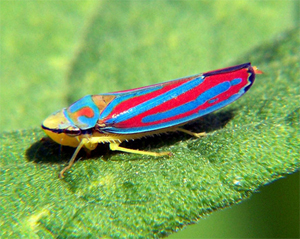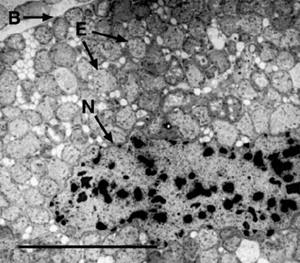 Graphocephala coccinea, the candy-striped leafhopper. Source: Wikimedia Commons. |
So here we have leafhoppers, like many other insects including aphids, feed almost exclusively on the phloem or xylem fluid of plants. With such a restricted diet, you are bound to run into nutritional deficiencies. Syrup is tasty, but I wouldn't want to subsist solely on it! What's an insect to do? The clear answer is to harvest those little nutrient-producing biological machines known as bacteria.
 An electronmicrograph of the bacteriome of Homalodisca coagulata. The plentiful irregular spheroids (E) are the bacterial symbionts, Baumannia cicadellinicola, the border at the top (B) is the bacteriocyte (single cell) boundary, and the large organelle in the middle (N) is the host cell nucleus. The scale bar is 10 μm. The cell is just packed with bacteria, isn't it? Source: Moran et al. 2003. |
The plant fluids usually consist of carbon and nitrogen sources such as amino acids, the building blocks of proteins. Xylem fluid chiefly contains non-essential amino acids such as glutamine and asparagine. Whereas most animals are incapable of modifying those raw materials into every other essential amino acid, vitamin, or cofactor they need thus requiring them to supplement their diet with foods with high concentrations of these necessary items, sap-sucking insects have solved the problem by entrusting the production of these necessary chemicals to their bacterial symbionts. These obligate intracellular bacteria are held within special organs called bacteriomes. The symbiotic bacteria are heritable, often transmitted from mother to egg, leading to interesting evolutionary questions. Some insects even have multiple symbionts which provide different chemicals for the host. For example, the glassy-winged sharpshooter (Homalodisca vitripennis) possesses a Gammaproteobacteria that provides vitamins and cofactors, while the Bacteroidetes (a different phylum entirely from the other symbiont species) synthesizes many of the essential amino acids.
Even more astonishing is the rate of genome size reduction seen in these symbionts. As is the case with the mitochondrion found in humans that harbor only 37 functional genes, the genomes of sap-sucking insect bacterial symbionts is heavily reduced. In the above glassy-winged sharpshooter example, the two bacterial symbionts have complementary genomes; that is, each genome has lost the functional genes that the other is responsible for.
Phylogenetic analysis of the hosts and symbionts reveal common evolutionary relationships, meaning that the relationships among the insect species is highly correlated with the symbiotic bacteria found within them. This indicates that the original infection and symbiosis was an ancient event occurring millions of years ago. Molecular clock data suggests that the common ancestor of the symbionts found in two genera in the subfamily Cicadellinae, Graphocephala and Homalodisca, lived sometime between 80 and 175 million years ago, which correlates well with the data on the divergence of the host insect species.
So next time you see these little garden pests think of all the complex reactions and relationships between host and symbiont when that leafhopper is feeding on your plants and admire the interesting evolutionary history of these organisms before you flick it off your prize raspberry bush.
References:
Moran, N., Dale, C., Dunbar, H., Smith, W., & Ochman, H. (2003). Intracellular symbionts of sharpshooters (Insecta: Hemiptera: Cicadellinae) form a distinct clade with a small genome Environmental Microbiology, 5 (2), 116-126 DOI: 10.1046/j.1462-2920.2003.00391.x
Wu D, Daugherty SC, Van Aken SE, Pai GH, Watkins KL, Khouri H, Tallon LJ, Zaborsky JM, Dunbar HE, Tran PL, Moran NA, & Eisen JA (2006). Metabolic complementarity and genomics of the dual bacterial symbiosis of sharpshooters. PLoS biology, 4 (6) PMID: 16729848
Really interesting post! What seems to be most fascinating about this is that the bacterial endosymbionts are actually inherited via their host. Do you know whereabouts on the insect body the bacteriomes are? I'm guessing they would be attached to the gut somehow...
ReplyDeleteThanks! That is the most fascinating aspect; their rapidly deteriorating genomes leaves them unable to live outside the host cells, much like mitochondria. This just happens to be a more recent and specialized association. The bacteriomes are typically situated laterally on both sides of the insect's abdomen actually near the epithelium. Interesting, no? I, too, would have assumed they would be near the gut to perform their given function.
ReplyDeleteThis post was highlighted in the weekly Research Blogging column at Seed Magazine by Dave Munger. Never expected that!
ReplyDelete